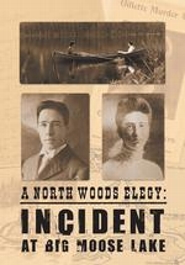
Filmmaker Derek Taylor recently visited campus to screen his documentary, A North Woods Elegy: Incident at Big Moose Lake, much of which was filmed on campus and in the community of Clinton. Taylor is an assistant professor at Southern Connecticut State University. North Woods Elegy, a 62-minute documentary, is Taylor’s first film and investigates the circumstances surrounding the murder of Grace Brown on Big Moose Lake in the Adirondacks State Park.
The screening was organized by Director of Special Collections and Archives Christian Goodwillie, whom Taylor contacted due to the film’s connections with Hamilton and the village of Clinton. Many of the film’s reenactment scenes were filmed in and around Clinton—scenes of Chester and Grace together were filmed at a house in the village of Clinton, and the scene of the two on a rowboat, prior to the murder, was filmed at the Hamilton Reservoir.
But besides having been filmed here, the documentary has another important tie to Hamilton: All of the primary documents related to the case—newspaper clippings, photographs, court records, correspondences, and even Chester’s personal prison diary—are housed in the Burke Library Special Collections.
The Special Collections began acquiring documents related to the case after a generous donation to the college by Ward Halverson ’92, great grandson of Herkimer County district attorney George Ward, Chester’s prosecutor. Halverson’s donation included the indictment, Grace’s autopsy report, the Glenmore Hotel registry, and a series of love letters between Chester and Grace.
In 2007, the library was again fortunate to receive a donation to the Special Collections. Marilynn Murray, grand-niece of Chester, found the diary in a closet, and found Hamilton after conducting a web search for information about Chester. The diary contains entries from September 19, 1907 to March 30, 1908, the day that he was executed.
The trial of Chester Gillette for the murder of Grace Brown stands as one of the most famous cases in the early 20th century. It has inspired numerous fictional books and films—including the Theodore Dreiser’s classic An American Tragedy and the 1951 Academy Award-winning film A Place in the Sun—but Taylor’s documentary is the first factual account of the story ever presented on screen. It focuses on the tumultuous relationship between Grace and Chester and Chester’s subsequent incarceration and execution, and features images from the case, interviews with authorities on the case, and reenactments.
Chester and Grace met in Cortland, N.Y. at Gillette Petticoats, where he was floor supervisor and she was a seamstress. Because Chester was forbidden to date an employee, the two struck up a secret relationship. In the spring of 1906, Grace became pregnant with Chester’s child.
Worried about the shame that she was sure to incur for becoming pregnant out of wedlock, Grace begged Chester repeatedly in the following month to marry her. Chester, who had a reputation as a bit of a philanderer, resisted through the spring and into the summer, until Grace threatened finally to tell the whole of Cortland of their affair if he did not marry her.
In July, Chester invited Grace to accompany him to “the north woods” for a short vacation. The two traveled together to Utica, stayed for a night, and continued the next day north to the Glenmore Hotel, near Big Moose Lake, where Chester registered under a false name. On the morning of July 11, 1907, the two rented a rowboat to take out on the lake. The canoe was found, upturned, the next morning. Grace’s body was at the bottom of the lake.
The autopsy determined that Grace died from two wounds on her head. Chester’s tennis racket (which witnesses had seen him carrying before and after the murder) was recovered buried in the woods nearby. Chester was convicted of first-degree murder by a jury at the Herkimer County Court and was executed in March of 1907.
The investigation and court proceedings made national news, and the trial stands today as a precedent for determining the legitimacy of circumstantial evidence in murder cases. Gillette claimed and maintained, up to his execution, that Grace attempted suicide that her head was wounded by the incidental capsizing of the rowboat.
Also present at the screening, participating in a question and answer panel discussion following the viewing, were case experts Jack Sherman and Craig Brandon, who together co-edited The Prison Diary and Letters of Chester Gillette (Richard W. Couper Press, 2007). Brandon is also author of Murder in the Adirondacks (North Country Books), an investigative account of the murder and trial, published in 1986.
Chester’s diary and Grace’s love letters were presented for public viewing at the screening.
Posted February 24, 2012
